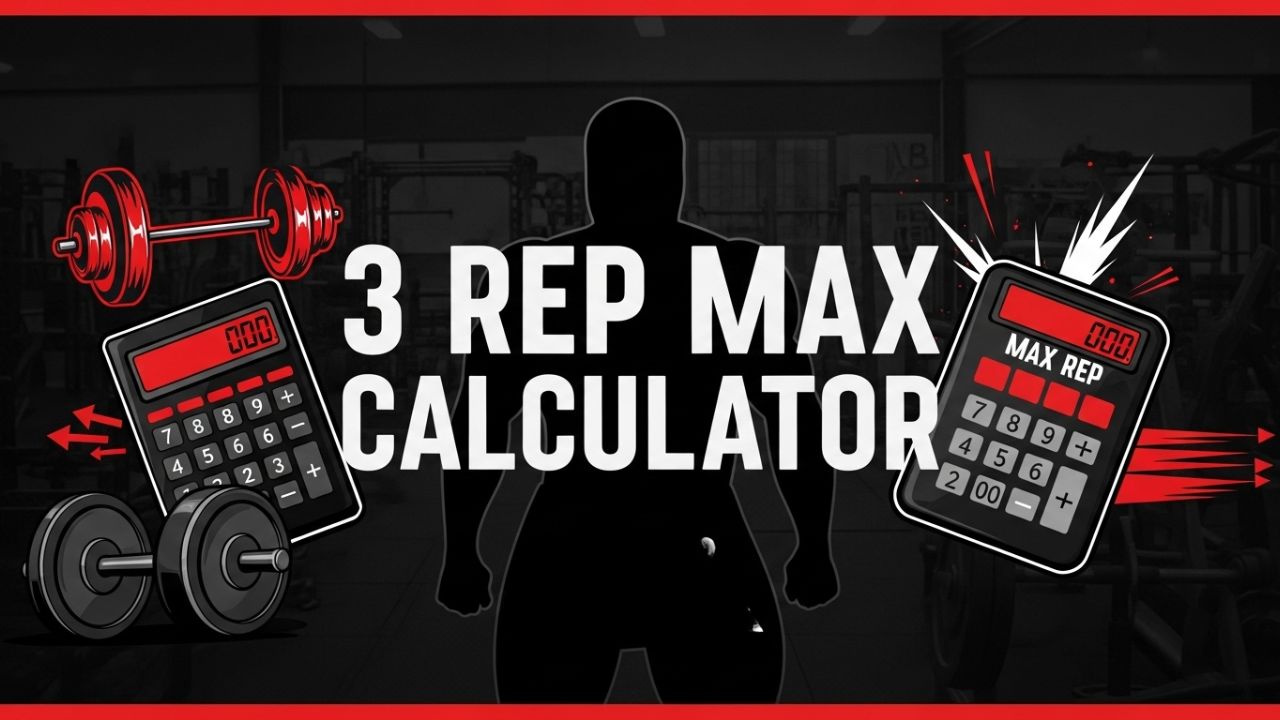🏋️ 3 Rep Max Calculator
Calculate your Three Rep Max (3RM) using scientifically validated formulas. Get personalized training recommendations and percentage-based workout plans optimized for strength, power, and muscle development.

Three Rep Max (3RM) Training
Scientific Foundation
The Three Rep Max (3RM) represents the maximum weight an individual can lift for exactly three repetitions with proper form. Research in Sports Medicine demonstrates that 3RM testing provides an excellent balance between strength assessment accuracy and safety compared to 1RM testing. The 3RM typically represents approximately 90% of an individual’s 1RM, making it a practical and safer alternative for strength evaluation.
Training Applications
Systematic reviews in strength training show that 3RM-based programming is particularly effective for intermediate to advanced athletes. Training at 85-95% of 3RM optimizes neural adaptations for maximum strength, while 70-85% promotes both strength and hypertrophy. The 3RM serves as an excellent benchmark for periodized training programs.
Safety Advantages
Sports injury research indicates that 3RM testing significantly reduces injury risk compared to 1RM attempts while maintaining high reliability for strength assessment. The ability to complete three repetitions allows for better form consistency and reduces the mechanical stress associated with absolute maximum efforts.
Practical Benefits
Contemporary strength research demonstrates that 3RM testing is more practical for regular assessment than 1RM testing. It can be performed more frequently without excessive fatigue, provides reliable data for program adjustments, and is particularly valuable for powerlifters and strength athletes in their training cycles.
3RM Calculation Methods & Formulas
Brzycki Formula for 3RM
Formula: 3RM = (1RM × 36 ÷ (37 – Reps)) × 0.90
Validation research
shows the Brzycki formula provides highly accurate 3RM predictions when combined with the standard 90% conversion factor.
This method is particularly effective for upper body exercises and repetition ranges of 2-10.
Epley Formula for 3RM
Formula: 3RM = (Weight × (1 + 0.0333 × Reps)) × 0.90
The Epley formula, when adjusted for 3RM calculation, provides excellent accuracy across multiple exercise types.
This formula is particularly versatile and works well for both compound and isolation movements, making it suitable
for comprehensive strength assessment programs.
Direct 3RM Testing
Protocol: Progressive loading to determine actual 3RM
Direct 3RM testing involves systematic load increases until the lifter can complete exactly three repetitions with
maximum effort. This method provides the most accurate assessment but requires proper warm-up protocols and adequate
recovery between attempts. Recommended for experienced lifters with proper supervision.
Average Method Accuracy
Approach: Combined formula average for enhanced precision
Using multiple formulas and averaging the results provides superior accuracy compared to single-formula calculations.
This method reduces individual formula bias and provides more reliable 3RM estimates across different population groups
and exercise variations.
3RM vs 1RM: Comparative Analysis
| Aspect | 3RM Testing | 1RM Testing | Advantage |
|---|---|---|---|
| Safety | Lower injury risk | Higher injury risk | 3RM |
| Form Consistency | Better form maintenance | Form may deteriorate | 3RM |
| Testing Frequency | Can test more often | Requires longer recovery | 3RM |
| Psychological Stress | Less intimidating | High psychological demand | 3RM |
| Training Specificity | More training-relevant | Rarely used in training | 3RM |
| Strength Assessment | Excellent indicator | Absolute maximum | Depends on goal |
When to Use 3RM Testing
Ideal Situations:
• Regular strength assessment during training cycles
• Intermediate to advanced lifters seeking safer testing
• In-season athletes who cannot afford high fatigue
• Powerlifters practicing competition commands
• Older adults or those with injury history
• When testing multiple exercises in one session
Standard 3RM Strength Benchmarks
Male 3RM Strength Standards (kg)
| Exercise | Beginner | Novice | Intermediate | Advanced | Elite |
|---|---|---|---|---|---|
| Bench Press | 35-50kg | 50-70kg | 70-90kg | 90-120kg | 120kg+ |
| Squat | 45-70kg | 70-90kg | 90-125kg | 125-160kg | 160kg+ |
| Deadlift | 55-85kg | 85-115kg | 115-150kg | 150-190kg | 190kg+ |
| Overhead Press | 20-35kg | 35-50kg | 50-65kg | 65-80kg | 80kg+ |
Female 3RM Strength Standards (kg)
| Exercise | Beginner | Novice | Intermediate | Advanced | Elite |
|---|---|---|---|---|---|
| Bench Press | 18-30kg | 30-45kg | 45-60kg | 60-75kg | 75kg+ |
| Squat | 25-45kg | 45-65kg | 65-85kg | 85-110kg | 110kg+ |
| Deadlift | 35-55kg | 55-75kg | 75-100kg | 100-130kg | 130kg+ |
| Overhead Press | 12-22kg | 22-32kg | 32-42kg | 42-55kg | 55kg+ |
3RM Standards Interpretation
These 3RM standards are based on extensive strength data from recreational to competitive lifters, adjusted to represent approximately 90% of 1RM values. Standards assume proper technique, adequate training experience, and good health status. Individual variations exist based on body weight, training history, genetics, and age. Use these as progressive targets rather than absolute requirements.
3RM-Based Periodization Model
| Training Phase | Duration | Intensity (%3RM) | Volume (Reps) | Sets | Rest Period | Primary Adaptation |
|---|---|---|---|---|---|---|
| Strength Foundation | 4-6 weeks | 60-75% | 8-12 | 3-4 | 2-3 min | Hypertrophy, technique |
| Strength Building | 4-6 weeks | 75-85% | 5-8 | 4-5 | 3-4 min | Strength development |
| Maximum Strength | 3-4 weeks | 85-95% | 3-5 | 4-6 | 4-5 min | Neural adaptation |
| Peaking | 2-3 weeks | 90-100% | 1-3 | 3-5 | 4-6 min | Competition prep |
| Deload | 1 week | 50-65% | 6-10 | 2-3 | 2-3 min | Recovery, maintenance |
3RM Periodization Benefits
Periodization research demonstrates that 3RM-based programming provides excellent strength development while maintaining training safety. The ability to regularly test and adjust 3RM values allows for more precise load prescription and better adaptation monitoring compared to theoretical 1RM-based programs.
Advanced 3RM Training Techniques
3RM Cluster Training
Protocol: 3 × (1+1+1) with 15-20 seconds between singles
Intensity: 90-100% 3RM
Benefits: Maintains power output, allows multiple 3RM attempts
This method enables lifters to practice 3RM loads more frequently while managing fatigue effectively.
3RM Wave Loading
Protocol: 80% × 3, 85% × 3, 90% × 3, repeat and increase
Application: Progressive waves building to 3RM
Benefits: Neural potentiation, gradual intensity increase
Particularly effective for competition preparation and strength testing sessions.
3RM Pause Training
Method: 2-3 second pauses at sticking points
Intensity: 85-95% 3RM
Benefits: Improved strength at weak points, competition simulation
Essential for powerlifters and strength athletes who must demonstrate control during competition lifts.
Frequently Asked Questions
How often should I test my 3RM?
Beginners: Every 6-8 weeks during strength phases
Intermediate: Every 4-6 weeks or at phase transitions
Advanced: Every 3-4 weeks during strength blocks
Competition Athletes: 2-3 weeks before competition
3RM testing can be performed more frequently than 1RM testing due to reduced fatigue and recovery demands.
What’s the proper 3RM testing protocol?
Warm-up Protocol:
1. General warm-up: 5-10 minutes light cardio
2. Dynamic stretching and activation
3. 50% 3RM × 5-8 reps
4. 70% 3RM × 3-5 reps
5. 80% 3RM × 3 reps
6. 90% 3RM × 3 reps
7. 3RM attempt
Rest 3-4 minutes between warm-up sets, 4-5 minutes before 3RM attempt.
How does 3RM relate to other rep maxes?
Standard Relationships:
• 1RM = 3RM ÷ 0.90 (approximately 111% of 3RM)
• 5RM = 3RM × 0.87 (approximately 87% of 3RM)
• 8RM = 3RM × 0.80 (approximately 80% of 3RM)
• 10RM = 3RM × 0.75 (approximately 75% of 3RM)
These relationships help in programming various training intensities based on 3RM values.
Is 3RM testing suitable for beginners?
3RM testing is generally more suitable for beginners than 1RM testing due to safety considerations. However, beginners should have at least 6-8 weeks of consistent training experience and demonstrate proper technique before attempting 3RM tests. Supervision by a qualified trainer is recommended for novice lifters during maximal testing sessions.
What are the signs of a successful 3RM attempt?
Technical Indicators:
• All three repetitions completed with proper form
• Consistent bar path and tempo
• No significant form breakdown on final rep
• Ability to control the weight throughout full range
• No assistance needed from spotters
If form deteriorates significantly or additional reps are clearly possible, the weight may not represent a true 3RM.
3RM Training Safety & Recovery
Pre-3RM Testing Preparation
24-48 Hours Before:
• Adequate sleep (7-9 hours)
• Proper hydration and nutrition
• Avoid intense training sessions
• Mental preparation and visualization
• Equipment check and preparation
Proper preparation significantly impacts 3RM performance and reduces injury risk.
Post-3RM Recovery Protocol
Immediate (0-2 hours): Light stretching, hydration, protein intake
24 Hours: Active recovery, adequate sleep, anti-inflammatory foods
48-72 Hours: Light training only, monitor for excessive soreness
Return to Training: Gradual intensity increase over 3-5 days
Proper recovery ensures adaptation and prepares the body for subsequent training.
Common 3RM Testing Mistakes
Avoid These Errors:
• Insufficient warm-up or excessive warm-up volume
• Too large jumps between attempts (>5-10%)
• Testing when fatigued or inadequately recovered
• Poor spotting or safety setup
• Attempting 3RM on unfamiliar exercises
• Testing multiple exercises in one session without proper planning
Related
- Barbell Racking Calculator
- Push-Up Weight Calculator
- Wilks Calculator
- DOTS Calculator
- One-Rep (1RM) Max Calculator
- One-Rep Max (1RM) Bench Press Calculator
References
- Mayhew, Jerry L; Johnson, Blair D; LaMonte, Michael J; Lauber, Dirk; Kemmler, Wolfgang (September 2008). “Accuracy of Prediction Equations for Determining One Repetition Maximum Bench Press in Women Before and After Resistance Training”. Journal of Strength and Conditioning Research. 22 (5): 1570–1577.
- Knutzen, Kathleen; Brilla, Lorraine; Caine, Dennis (August 1999). “Validity of 1RM Prediction Equations for Older Adults”. The Journal of Strength & Conditioning Research. 13 (3): Vol 13, Issue 3, Page 242–246. Retrieved 11 July 2014.
- Epley, Boyd (1985). “Poundage Chart”. Boyd Epley Workout. Lincoln, NE: Body Enterprises. p. 86.
- Brzycki, Matt (1998). A Practical Approach To Strength Training. McGraw-Hill.
- Kemmler, Wolfgang K.; Lauber, Dirk; Wassermann, Alfred; Mayhew, Jerry L. (2006-11-01). “Predicting maximal strength in trained postmenopausal woman”. Journal of Strength and Conditioning Research. 20 (4): 838–842.
- LeSuer, Dale A.; McCormick, James H.; Mayhew, Jerry L.; Wasserstein, Ronald L.; Arnold, Michael D. (November 1997). “The Accuracy of Prediction Equations for Estimating 1-RM Performance in the Bench Press, Squat, and Deadlift”. Journal of Strength and Conditioning Research. 11 (4): 211–213.
- Reynolds, JM; Gordon, TJ; Robergs, RA (August 2006). “Prediction of one repetition maximum strength from multiple repetition maximum testing and anthropometry” (PDF). Journal of Strength and Conditioning Research. 20 (3): 584–92.
- Naclerio Ayllón, Fernando; Jiménez Gutiérrez, Alfonso; Alvar, Brent A.; Peterson, Mark D. (2009). “Assessing strength and power in resistance training”. Journal of Human Sport and Exercise. 4 (2): 100–113.

Manish is a NASM-certified fitness and nutrition coach with over 10 years of experience in weight lifting and fat loss fitness coaching. He specializes in gym-based training and has a lot of knowledge about exercise, lifting technique, biomechanics, and more.
Through “Fit Life Regime,” he generously shares the insights he’s gained over a decade in the field. His goal is to equip others with the knowledge to start their own fitness journey.
